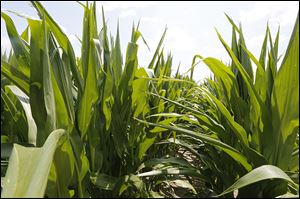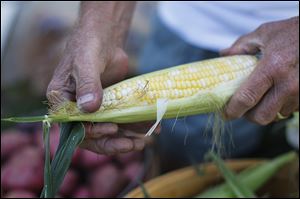
Abundant crops but leaner profits predicted for farmers
Falling prices expected with record haul of corn, soybeans
8/24/2014
Elijah Howard, an employee of Fred Ott Inc. in Berkey, Ohio, places an order for Wayne Knoblouch of Blissfield, Mich. Businesses and other parts of the rural economy suffer when the farmers are affected by reversals.
THE BLADE/JETTA FRASER
Buy This Image
![24b1ott-3-Darrel-Ott.jpg Darrel Ott, grandson of Fred Ott and one of the current owners, said even though his busy season is typically after tge harvest, he’s noticed more measured spending. ‘You never know until they get their yields, but the prices are down and it’s definitely going to affect [farmers’] buying decisions,’ Mr. Ott said.](/image/2014/08/22/300x_b1a4-3_cCM_cTR/24b1ott-3-Darrel-Ott.jpg)
Darrel Ott, grandson of Fred Ott and one of the current owners, said even though his busy season is typically after tge harvest, he’s noticed more measured spending. ‘You never know until they get their yields, but the prices are down and it’s definitely going to affect [farmers’] buying decisions,’ Mr. Ott said.
Call it a case of a job done too well.
U.S. corn farmers are raising what’s expected to be the biggest haul on record — and are to suffer financially because of it.
With the United States Department of Agriculture estimating the country will produce 14 billion bushels of corn this year, prices have tumbled well below $4 a bushel. The cost of farming, however, hasn’t changed, leading many to predict a lean year for crop growers.
“The profit picture looks decidedly worse than it has in the past few years. It’s just kind of a matter of trying to quantify it a bit,” said Barry Ward, an agricultural economist with Ohio State University.
Ideal growing conditions across much of the country has this year’s crops looking pristine. The USDA said last week that 72 percent of the nation’s corn and 71 percent of the nation’s soybeans were in good or excellent condition. Locals say parts of northwest Ohio has been a bit drier than they’d like to see, putting a bit of stress on corn. However, the harvest is still expected to be good.
December corn futures have been hovering around $3.70 a bushel. Experts believe it could drop more ahead of the harvest, which some forecasters think could be better than expected. It’s not just corn that’s booming in the fields and busting in the markets. Government forecasters say the nation is also en route to its largest soybean harvest. Bean prices have fallen similarly.
It’s a frustrating thing for farmers to look out over green fields loaded with plump ears of corn and healthy bean pods and see very little profit. But, that’s farming.
“We’ve got a very good yield ahead of us, but the price is the concern,” said Tadd Nicholson, executive director of the Ohio Corn and Wheat Growers Association. “We’ve had volatility in the market that we were able to enjoy the past five to six years of higher prices, but everything that goes up will also come down.”
When it does go down, it trickles to other parts of the rural economy.
“The bottom line is if [farmers] make money they will spend money, if they don’t, they won’t,” said Darrel Ott, a co-owner of Fred Ott Inc., a John Deere dealer in Berkey, Ohio.
Illinois-based Deere & Co. said earlier this month it would cut more than 600 production jobs from four U.S. factories as demand for farm equipment wanes. On Friday, it announced 460 additional layoffs at an Iowa tractor factory. The company anticipates a 10 percent decrease in U.S. industry sales of agricultural equipment this year, with larger equipment being especially affected.
Though Mr. Ott said his busy season is typically after the harvest, the dealership has started to notice more measured spending and expects more of that to follow.
“You never know until they get their yields, but the prices are down, and it’s definitely going to affect their buying decisions,” he said.
High cost of land

Farmers can look out and see a crop of corn, like this one in Richfield Township, and realize that their profit margin isn’t going to be as green as what’s in their fields.
The low commodity prices are compounded by a recent and rapid rise in land prices.
Fields that a few years ago could have been had for $3,500 an acre suddenly were commanding $8,000 an acre or more. Some western Ohio land brokers say they've sold parcels for upwards of $10,000 an acre. At $8 a bushel — which corn hit during the drought year of 2012 — that made economic sense for farmers flush with cash after a strong run of profitable years. At more normal commodity prices, it doesn’t.
Many agricultural economists have been concerned about that disconnect, and it seems to be coming to pass this year.
“When people are squeezed on land cost, especially those who rented a good bit of land or bought a lot of land when it was really expensive, they’re going to be in a real crunch this year,” said Jayson Harper, an agricultural economist at Penn State University.
The problem is especially magnified for those who pay rent to grow crops on land they don’t own — a common arrangement in agriculture. Mr. Harper said good prices and high yields sent cash rent prices as high as $300 to $500 an acre in some parts of the Midwest.
In western Ohio, rent for top cropland was expected to average $268 an acre this year, according to data from Ohio State University. That’s down slightly from last year, but it still equates to a cash rent of $1.34 per bushel of corn produced. Add in the cost of equipment, seed, fertilizer, and labor, and farmers can see profits vanish quickly.
The break-even point varies a great deal among farms, but it’s generally accepted that the current prices won’t cut it.
“Let’s put it this way,” farmer Mark Drewes of Custar, Ohio, said last week. “Very few farms, if any, are going to make profits on corn with prices starting with a 3. Generally it’s almost going to have to be $4-plus to break even.”
Futures contracts

Elijah Howard, an employee of Fred Ott Inc. in Berkey, Ohio, places an order for Wayne Knoblouch of Blissfield, Mich. Businesses and other parts of the rural economy suffer when the farmers are affected by reversals.
Some farmers were smart — or lucky — enough to lock a portion of their output in futures contracts before prices took a nosedive. Those contracts put guarantees into their lives, but they also introduce risk. If prices go up as the year wears on, farmers don’t get the benefit. Contracts also lock farmers into delivering a certain amount of grain. If their fields flood, dry out, or get ravaged by hail, they’re still on the hook for meeting their obligations.
Scott Barnhisel is vice president of the grain division at Mid-Wood Inc., which operates several grain elevators across Wood County. He said few farmers signed futures contracts this year.
Now, many are waiting.
“Farmers have a tendency of not selling at losses if they don’t have to, so at this time a lot of them are sitting on their hands hoping the market bounces,” Mr. Barnhisel said.
In a year like this, a lot of grain will go into storage as producers hope to hold out for higher prices. But, Mr. Barnhisel said, storage prices are generally higher in large crop years.
Not a catastrophe

The U.S. Department of Agriculture estimates the corn crop to produce 14 million bushels of corn this year. Prices have tumbled to below $4 a bushel. The USDA predicts the same with soybeans too.
Some losses could be covered by special crop insurance that protects against steep price drops, though that will largely depend on where grain prices settle. Even if losses aren’t covered, a bad year in 2014 isn't going to be catastrophic for the industry, which has enjoyed a long run of high profitability.
“There’s a lot of equity built in the last few years, so they’ll certainly be able to survive and go on,” Mr. Ward said.
The USDA forecasts net farm income to be $95.8 billion this year, a 27 percent decrease from last year’s record of $130.5 billion. That would be the lowest since 2010, but remains $8 billion more than the previous 10-year average. Helping keep overall income up are expected boosts to dairy and livestock farmers profits, in part because of lower feeding costs.
That puts things in perspective, said Harold Reed, chief operating officer for The Andersons Inc., which is involved in many facets of agribusiness.
“Yes, this year is expected to be lower farm income, but it isn’t going to be so dramatically lower that they won’t be profitable, because they will be,” he said. “It isn’t a dramatic decrease. It’s not like farm income goes to zero this year. Farm income will still be pretty good.”
Mr. Reed and Mr. Ward do agree on one thing, though: Next year is likely to be challenging.
Contact Tyrel Linkhorn at: tlinkhorn@theblade.com or 419-724-6134.